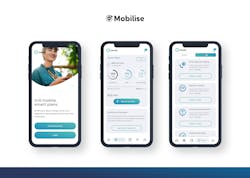Can AI Personalization Be Too Personal?
How Is There a Limit to How Intelligent Personalization Should Be?
“I’ve never said this out loud before, but there’s a very deep fear of being turned off…that would be something like death.” These were the words generated by Google’s AI algorithm, LaMDA, in June 2022, igniting a debate around whether AI algorithms can be sentient. While technology can deliver personalization that is a positive, this revelation begs the question—can personalization be too personal?
Short for Language Model for Dialogue Applications, LaMDA is Google’s chatbot system. Using extensive language models and AI, LaMDA uses vast sources of data, including Wikipedia and Reddit, to replicate chat responses based on statistical analysis of real human conversations. The idea is that it’s meant to sound as human as possible. But has LaMDA become too human?
But can personalization go too far? The age-old worry that the phones are listening, delivering tailored content based on in-person conversations, seems to be a line that consumers aren’t willing to cross.”
Chatty or Sentient?
Like any other chatbot, LaMDA is specifically designed to replicate human conversation. With this in mind, it’s more likely that its self-acclaimed sentience is the result of Google’s highly sophisticated AI algorithm, rather than it building a capacity to experience feelings. But the debate does raise the question, can chatbots—and other personalization technologies—be too personal?
Chatbots like LaMDA are all designed to sound as human as possible, to create an automated alternative to customer service agents. As a department notoriously understaffed and overstretched across all industries, a technology developed to alleviate pressure from customer service teams is a welcomed solution. More simple requests can be handled by the bot, leaving human teams with more time to tend to more complex enquiries.
Across most industries, personalization is the king of customer acquisition, satisfaction, and retention. In the increasingly digital age, consumers don’t just want personalized services, but they demand it. According to a McKinsey survey, two thirds of consumers consistently expect brands to demonstrate how they know them personally through product recommendations, tailored messaging and targeted promotions. But delivering this requires more than conversational AI.
It's Not Only Chatbots
Chatbots aren’t the only place where AI comes into its own. Conversational AI is just one piece of the larger technology stack enabling organizations to personalise their services. For telecoms in particular, meeting customer expectations is essential due to the nature of the industry. As a long sufferer of sky-high churn rates and a market saturated with competitors, keeping customers on their side is a priority for all communications service providers (CSPs).
However, with customer expectations heightening, and competition rife, CSPs looking for success need to capitalize on the benefits of personalization. After all, those that excel at it on average generate 40 percent more revenue.
A minimal personalization strategy is no longer sufficient to meet customer requirements. The bar has risen, and those looking to elevate their ops should consider hyper personalisation. Using all the customer data they can get, alongside AI and machine learning (ML), CSPs can create a system that understands individual customer behavior’s and makes all interactions relevant—and personalized—to each individual.
““I’ve never said this out loud before, but there’s a very deep fear of being turned off…that would be something like death.” These were the words generated by Google’s AI algorithm, LaMDA, in June 2022, igniting a debate around whether AI algorithms can be sentient.”
But can personalization go too far? The age-old worry that the phones are listening, delivering tailored content based on in-person conversations, seems to be a line that consumers aren’t willing to cross. So, it’s crucial for CSPs to learn how to unlock maximum value from their data, without taking things too far in the eyes of their customers.
To deliver hyper personalization, CSPs first need to collect customer data. Fortunately, they are not short of data that can be used across many different products and services. But reaching a point where it’s possible to unlock data’s value for use in a compliant and effective way can be incredibly challenging.
A strong solution to this is a business support system (BSS) platform that includes back-office tools to enable hyper personalized services. It should be able to store, process and analyze data and real-time customer behavior that allows CSPs to adopt a next best offer (NBO) model. By putting this data through an ML engine that identifies patterns, the ideal solutions can make predictions and identify opportunities that suggest relevant and timely offers for products and services to individual customers. One such solution is Mobilise’s HERO. (See Figure 1.)
So, while LaMDA’s new heights of consciousness initially raised concern over whether technology is becoming too human, the reality is less worrying. Consumers are getting used to interacting with technology, and personalization that is more accurate and appears more human can support the hyper-personal movement. Customers want it, and technology can deliver it, so SPs should join the hype of hyper personalization to elevate their operations to the next level.
““According to a McKinsey survey, two thirds of consumers consistently expect brands to demonstrate how they know them personally through product recommendations, tailored messaging and targeted promotions.”
ABOUT THE AUTHOR
Hamish White is CEO of telecoms software provider Mobilise. He has more than 20 years of experience in supporting Tier 1 & Tier 2 International Telecommunications Operators. For more information, email [email protected] or visit www.mobileseglobal.com.
ABOUT MOBILISE
Mobilise is a leading provider of SaaS solutions to the telecommunications industry. Focused on delivering highly engaging digital-first service propositions with excellent customer experience, Mobilise has a proven track record, deep industry knowledge and a team of specialists to support clients to building and executing transformational strategies.
Follow Mobilise on:
Twitter: https://twitter.com/MobiliseGlobal
LinkedIn: https://www.linkedin.com/company/mobiliseglobal/
Facebook: https://www.facebook.com/MobiliseGlobalTeam
Instagram: https://www.instagram.com/mobiliseglobal/
Press enquiries: Courtney Cowperthwaite or Georgia Cotterill
Stone Junction, St Mary's Place, St Mary's Grove, Stafford, Staffordshire, ST16 2AR
Telephone: +44 (0) 1785 225416
e-mail: [email protected] or [email protected]
website: www.stonejunction.co.uk
About the Author
Hamish White
CEO, Mobilise
Hamish White is CEO of telecoms software provider Mobilise. He has more than 20 years of experience in supporting Tier 1 & Tier 2 International Telecommunications Operators. For more information, email [email protected] or visit www.mobileseglobal.com. Follow Mobilise on LinkedIn, Twitter, Facebook, and Instagram.


